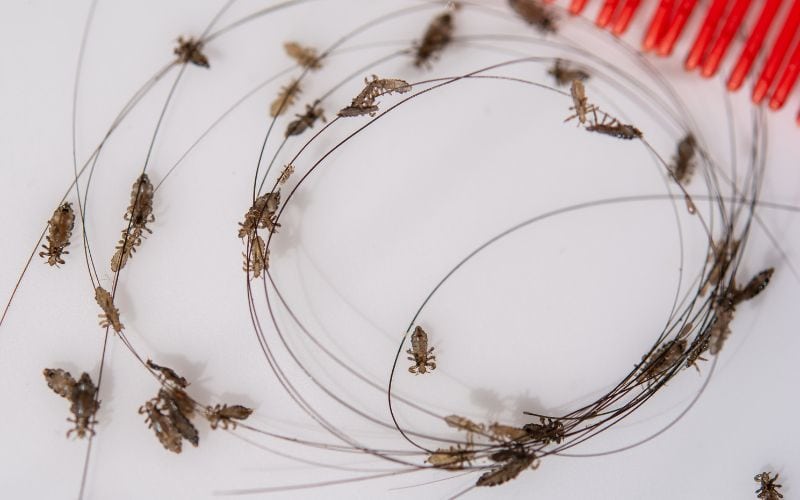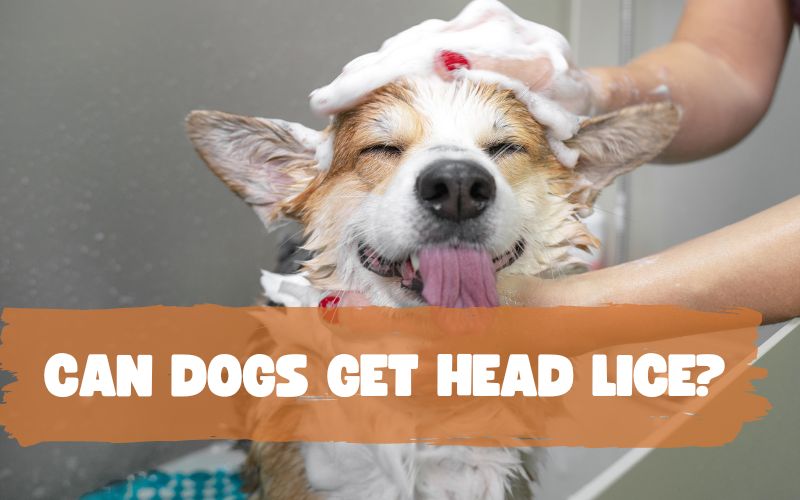Have you ever found yourself puzzling over the question, “Can dogs get head lice?” Although it’s natural to worry about your furry friend catching creepy crawlers, human head lice are species-specific and cannot survive on dogs.
Dogs can get specific types of dog lice, such as Trichodectes canis and Linognathus setosus.
In this article, we’ll delve deeper into the subject of dog lice – from their origin to symptoms and treatment options available.
Stick around to learn more about this less common but equally important aspect of pet care.
Key Takeaways
- Human head lice cannot survive on dogs, as they are species-specific parasites.
- Dogs can get specific types of lice, such as Trichodectes canis and Linognathus setosus.
- Direct transmission of head lice between dogs and humans is unlikely, but sharing bedding or brushes among pets can be a potential transmission avenue for dog-specific lice variants.
- Symptoms of lice in dogs include itching, dry coat, hair loss, and tiny white flakes (nits) in the fur.
- Treating and preventing lice infestations in dogs involves using products specifically designed to kill lice, combing out any remaining bugs or eggs from the fur, cleaning the living environment thoroughly, maintaining good hygiene practices for your pet, and consulting with a veterinarian for guidance.
Can Dogs Get Lice from Humans?
Contrary to common belief, dogs can’t get head lice from humans. Lice are species-specific parasites that strongly prefer to stick with their original hosts. This means that human head lice stay on humans, and dog head lice remain on dogs.

While an errant insect may occasionally hitch a ride on your pet, it won’t set up residence and start a colony since the environment isn’t suitable.
However, our canine friends are still immune from these pesky invaders. Dogs have a variety of lice – Trichodectes canis and Linognathus setosus being the main culprits. These lice tend to infest animals in poor hygiene conditions or compromised health.
Even though direct transmission of head lice between dogs and humans is unlikely, dog owners must be aware of other transmission avenues for dog-specific variants, like sharing bedding or brushes amongst pets.
Should you suspect your furry companion is harboring these unwelcome guests due to persistent scratching or itching symptoms, consult a veterinarian promptly for accurate diagnosis and effective treatment options available, including over-the-counter shampoos or sprays specifically formulated for treating such infestations in dogs.
How Dogs Get Lice
Dogs primarily get lice through direct contact with other infested dogs. These small, wingless insects, known as Trichodectes canis and Linognathus setosus, are passed from one dog to another when they play or come into close contact at parks, kennels, shelters, or grooming salons.
Unlike fleas and ticks that can jump great distances, lice cannot hop or fly, thus making physical contact the primary transmission mode.
The environment also plays a critical role in aiding the spread of these parasites among dogs. Lice eggs, commonly called “nits,” can cling to shared bedding, brushes, collars, and other objects within the pet’s living area.
When a non-infected dog uses these items or frequents such infected areas, they run the risk of hosting these unwanted guests on their body. However, it is essential to note that maintaining excellent hygiene and cleanliness can significantly reduce this risk factor for your furry friend.
Symptoms of Lice in Dogs
Dog lice are tiny parasitic invaders that not only cause severe discomfort but, if left untreated, may also affect your faithful companion’s health. A dog with head lice commonly showcases a series of symptoms that can be early signposts to the presence of these skin parasites.
One of the most obvious signs is itching and discomfort, as dogs with head lice invariably scratch, bite, or rub infested areas.
Another noticeable symptom in your pet could be an unusually rough, dry coat accompanied by significant hair loss, especially around the ears, necks, shoulders, groin, and rectal regions.
This condition hints at an ongoing fight between canine comfort and relentless lice activity. Furthermore, you might notice tiny white flakes deep within your canine’s coat – another telltale sign indicating the presence of louse eggs or nits.
While diagnosing head lice in dogs during the early stages might prove challenging for some owners due to their minuscule size and camouflaging abilities on fur, redness, and inflammation on skin coupled with visible movement amongst hairs can help confirm the presence of these bothersome bugs.
These distressing symptoms will likely give rise to your furry friend’s restlessness. In such cases, it becomes vital to consider options like dog head lice treatments or consult a vet for professional advice promptly.
Treating and Preventing Lice in Dogs
To effectively treat and prevent lice infestations in dogs, it’s essential to take a comprehensive approach.
First, you’ll need to kill any existing lice on your dog. Various spot-on products, shampoos, collars, sprays, or dusts specifically target and eliminate lice. Make sure to follow the instructions provided by the product manufacturer carefully.
Next, removing the lice and their eggs from your dog’s coat is crucial. This can be done using a fine-toothed comb designed for this purpose. Regularly comb through your dog’s fur to catch any remaining lice or eggs that may have survived treatment.
In addition to treating your dog directly, cleaning their living environment thoroughly is essential. Lice can survive off their host for a short period, so washing all bedding, toys, and other items that come into contact with your dog is necessary.
Vacuuming carpets and upholstery can also help eliminate any lingering lice or eggs. Preventing future infestations requires maintaining good hygiene practices for your dog. Regular grooming sessions keep their coat clean and allow you to check for signs of lice early on.
Additionally, keeping your pet’s living areas clean and well-maintained plays a significant role in preventing re-infestation.
Consult with a veterinarian if you suspect or confirm a lice infestation in your furry friend. They can guide the most suitable treatment options based on the severity of the infestation and recommend preventive measures tailored to your specific situation.
To keep your pet comfortable and free from the annoyance caused by lice, it’s important to take immediate action and regularly implement effective prevention strategies at the first sign of trouble. This will help you keep lice infestations under control.
Conclusion
Dogs cannot get head lice from humans, and vice versa. Lice are species-specific parasites that require specific hosts to survive and reproduce.
While it’s essential to be aware of the various parasites that can affect our furry friends, lice infestations in dogs are relatively rare compared to other parasites like fleas.
If you notice any lice symptoms in your dog, consult a veterinarian for proper diagnosis and treatment options. Remember, there is no need to panic about dogs getting head lice from humans – it simply doesn’t happen.
